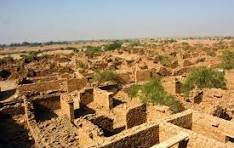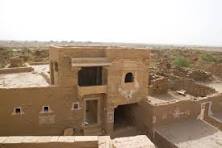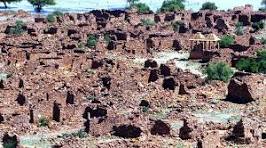Last updated on March 18, 2024

Nestled in the vast expanse of the Thar Desert in the western Indian state of Rajasthan lies the enigmatic village of Kuldhara. Known for its deserted landscape and a lingering sense of abandonment, Kuldhara has become synonymous with haunted tales and ghostly legends that have captivated the imagination of locals and visitors alike
1. Historical Background:
Kuldhara’s history dates back to the early 19th century when it was a thriving settlement of Paliwal Brahmins, an ancient Hindu community. The village was not just a cluster of houses; it was a testament to the resilience and resourcefulness of its inhabitants who had managed to create an oasis in the arid desert landscape. However, the prosperity of Kuldhara took a sudden and mysterious turn.
According to local folklore, the Paliwal Brahmins abruptly abandoned Kuldhara and the nearby villages in 1825. The reasons behind this mass exodus remain shrouded in mystery, with various theories attempting to unravel the enigma. One prevalent narrative suggests that the ruling minister of the region imposed exorbitant taxes on the villagers, leading to economic hardship. Additionally, there were reports of the minister’s oppressive behavior, including harassment and ill-treatment of the Brahmin community.
Another theory points to the scarcity of water in the region, a precious resource in the unforgiving desert environment. The villagers, unable to sustain their agricultural practices and livelihoods, might have decided to seek greener pastures elsewhere. The abrupt nature of their departure, however, raises questions about whether there was a more sinister force at play.

2. The Curse of Kuldhara:
As the Paliwal Brahmins left Kuldhara and the neighboring villages, they are said to have cursed the land, ensuring that no one could ever settle or thrive in those abandoned spaces again. This curse, according to local beliefs, is responsible for the eerie atmosphere that permeates the deserted village. The sense of desolation and the mysterious circumstances surrounding the abandonment have given rise to tales of paranormal activity.
3. Paranormal Legends:
Kuldhara’s haunted reputation has attracted paranormal enthusiasts, historians, and curious travelers from around the world. Visitors claim to have experienced strange occurrences, from unexplained sounds and whispers to sightings of shadowy figures. Some report feeling an otherworldly presence as they wander through the dilapidated structures and deserted streets.
The abandoned houses, their doors ajar, and the empty courtyards add to the haunting ambiance. Stories circulate about the voices of children playing in the distance, laughter echoing through the ruins, and flickering lights in the abandoned structures. Locals speak of inexplicable happenings, attributing them to the restless spirits of the Paliwal Brahmins who left Kuldhara under duress.
4. The Archaeological Aspect:
While the legends and ghostly tales contribute to the allure of Kuldhara, it’s crucial to approach the village with a historical perspective. The Archaeological Survey of India (ASI) has recognized the significance of Kuldhara as a heritage site. The ruins provide insights into the architectural style and daily life of the Paliwal Brahmins in the 19th century.
The abandoned structures, though weathered by time, still stand as a testament to the once-thriving community. The layout of the village, with its narrow lanes and interconnected houses, reflects a well-planned settlement. The ASI has taken measures to preserve and protect Kuldhara, ensuring that future generations can explore its historical and cultural importance.

5. Exploring Kuldhara:
For those daring enough to venture into the haunted realm of Kuldhara, there are opportunities to explore the village during daylight hours. The sun casting shadows on the crumbling structures creates a surreal atmosphere, allowing visitors to envision the village as it once was. The empty courtyards, remnants of ornate architecture, and the ghostly silence evoke a sense of nostalgia for a bygone era.
Guided tours are available, providing historical insights into the lives of the Paliwal Brahmins and the events leading to the village’s abandonment. Tour guides often share local folklore, adding an extra layer of mystique to the experience. Visitors are advised to respect the historical and cultural significance of the site, refraining from engaging in activities that may disturb the fragile remains of the village.
6. Debunking the Paranormal:
While the tales of haunting and paranormal activity continue to circulate, skeptics argue that the legends of Kuldhara may be rooted more in folklore than in reality. The human tendency to attribute unexplained phenomena to the supernatural, combined with the allure of a mysterious narrative, could contribute to the village’s haunted reputation.
Some paranormal investigators and skeptics have visited Kuldhara to debunk the myths surrounding the deserted village. They argue that natural elements, such as wind and temperature variations, may be responsible for the reported paranormal experiences. Additionally, the power of suggestion, fueled by the haunting legends, could lead visitors to interpret ordinary sounds and sights as ghostly encounters.
7. Cultural Significance:
Beyond its haunted reputation, Kuldhara holds cultural significance as a place that preserves the history and heritage of the Paliwal Brahmins. The village stands as a symbol of resilience and community, showcasing the architectural prowess of its erstwhile inhabitants. The deserted streets and crumbling structures silently narrate the tale of a once-thriving community forced into exile.
Kuldhara serves as a reminder of the complex interplay between historical events, societal pressures, and the environment. The village’s abandonment remains a poignant chapter in Rajasthan’s history, sparking discussions about the need for sustainable practices and the preservation of cultural heritage.

* Conclusion:
Kuldhara Village, with its haunting legends and deserted landscape, invites exploration into the realms of history, culture, and the supernatural. While the ghostly tales add a layer of intrigue, it’s essential to approach the village with a balanced perspective, appreciating both the folklore and the historical significance it holds.
Whether one believes in the paranormal or dismisses it as a product of imagination, Kuldhara stands as a tangible link to the past, urging visitors to contemplate the mysteries that surround its abandonment. As the sun sets over the Thar Desert, casting long shadows on the deserted village, the enigma of Kuldhara continues to captivate those who seek to unravel its secrets.
